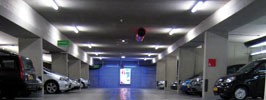

Excerpted and adapted from Security Planning and Design: A Guide for Architects and Building Design Professionals.
The security objective of a parking facility is to provide safe and secure vehicular parking environments in configurations that may include surface parking adjacent to a building, surface parking remote from a building, a standalone parking structure, or an interior parking area in a building containing other uses. The considerations and features described here apply to all of these configurations unless indicated.
Natural measures
* Depending on a parking facility's proximity to other buildings and the results of a risk assessment, consider hardening the parking structure.
* For standalone parking structures, access and egress for vehicles and pedestrians is generally limited to a portal for each purpose. There are no points of entry leading to secure building areas.
* Parking areas in buildings are accessed through a control or entry point at street level. To the extent possible, interior parking is situated away from critical business units and other plant facilities. Consideration may be made for blast mitigation of the area if the building superstructure is supported by the parking structure.
* Site and landscape elements may enhance positive access control for remote surface parking areas.
* Adjacent surface parking can be controlled by a secure perimeter around the parking site. The perimeter can be protected through use of site elements such as beams, shrubs, fencing, gates, or bollards. Access and egress are limited to one portal.
* Both remote and adjacent surface parking facilities can maintain lines of sight from the building by having trees no higher than eight feet and construction and landscaping no higher than three feet. The parking is situated with a sufficient amount of standoff distance to mitigate explosive effects on adjacent buildings within accepted client parameters.
* Adequate lighting is critical to support surveillance and integral to personnel safety and security. Clear sight lines should afford surveillance of parking areas.
* Adequate standoff distance is provided between the access control mechanism (eg, electronic gate or arm) and the entry portal so that unauthorised incoming vehicles can be moved so they do not interfere with authorised incoming traffic.
* Consider separating visitor parking from employee parking.
Mechanical measures
* Positive control may be accomplished through a road blocker and rising barrier configuration in both entry and exit lanes, care access or ticket dispenser for entry, and staffed egress controls as the exit barrier.
* Exit lanes can be equipped with a barrier (movable arm and tyre shredder) to prevent entry and a loop detector that allows egress from the secure side of the access control barrier.
* Staffed control points can provide continuous surveillance via fixed CCTV camera(s).
* Typically, card-based access control systems are used at all doors inside the parking facility with direct access to secured building areas or elevator lobbies. Elevator lobbies servicing parking areas provide free access at all points only when they are separated from main building elevators.
* Depending on the facility configuration, a mix of pan-tilt and fixed cameras or all fixed or all pan-tilt cameras can be used for surveillance of parking areas. The level of surveillance (100% coverage or other) depends on client preferences and risk assessment. With additional security devices inside the parking facility (eg, intercoms, emergency telephones, area detection and audio detection devices), automatic video scene call-up for operator assessment is desirable.
* Intercoms are typically used for access and egress control, along with elevator lobby communications. Intercoms used in combination with CCTV assessment provide for better security.
* Emergency call stations are strategically placed within parking facilities (central or multiple locations). Emergency call stations can be integrally linked with CCTV assessment.
* Audio detection devices may be used in stairs to detect screams or other signs of distress. These may be linked to fixed cameras in stairs.
* Cameras can record constantly or may be event-driven. Video motion can detect oncoming vehicles or personnel entering a parking area.
Organisational measures
* Parking restrictions and procedures should be strictly followed.
* Security patrols of parking areas should be frequent.
* Contract parking operations personnel should have limited security functions.
Republished with permission from The American Institute of Architects, www.aia.org.

© Technews Publishing (Pty) Ltd. | All Rights Reserved.